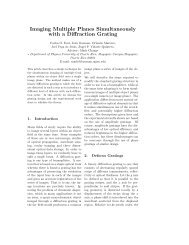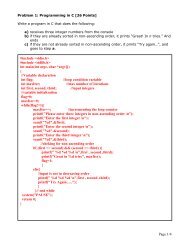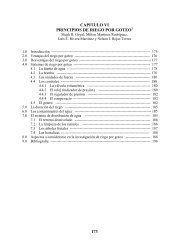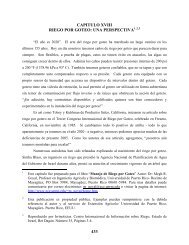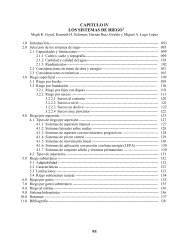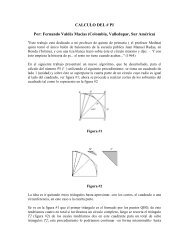Capítulo VI: Principios de Riego por Goteo
Capítulo VI: Principios de Riego por Goteo
Capítulo VI: Principios de Riego por Goteo
You also want an ePaper? Increase the reach of your titles
YUMPU automatically turns print PDFs into web optimized ePapers that Google loves.
No hay barrera más gran<strong>de</strong> que la que<br />
uno mismo cree, sigue a<strong>de</strong>lante.<br />
Osvaldo Caraballo<br />
Manejo <strong>de</strong> <strong>Riego</strong> <strong>por</strong> <strong>Goteo</strong><br />
<strong>por</strong> Megh R.Goyal<br />
1
CAPITULO <strong>VI</strong><br />
PRINCIPIOS DE RIEGO POR<br />
GOTEO<br />
Megh R. Goyal, Milton Martínez,<br />
Luis E. Rivera Martínez y<br />
Nelson I. Rojas Torres
<strong>Capítulo</strong> <strong>VI</strong>: <strong>Principios</strong> <strong>de</strong> <strong>Riego</strong> <strong>por</strong> <strong>Goteo</strong><br />
INTRODUCCION<br />
1. La <strong>de</strong>manda agua disponible es cada vez más aguda en la<br />
mayor parte <strong>de</strong>l mundo .<br />
2. El riego <strong>por</strong> goteo es uno <strong>de</strong> los sistemas más eficaces que se<br />
ha diseñado para usar el agua en los cultivos agrícolas.<br />
3. El riego <strong>por</strong> goteo es la aplicación lenta y frecuente <strong>de</strong> agua<br />
al suelo mediante emisores o goteros localizados en puntos<br />
específicos.<br />
Manejo <strong>de</strong> <strong>Riego</strong> <strong>por</strong> <strong>Goteo</strong><br />
<strong>por</strong> Megh R.Goyal<br />
3
<strong>Capítulo</strong> <strong>VI</strong>: <strong>Principios</strong> <strong>de</strong> <strong>Riego</strong> <strong>por</strong> <strong>Goteo</strong><br />
INTRODUCCION<br />
4. Se cree que el riego <strong>por</strong> goteo se empezó a usar en 1950<br />
<strong>por</strong> un ingeniero israelí.<br />
5. El origen <strong>de</strong>l concepto básico <strong>de</strong> riego <strong>por</strong> goteo pue<strong>de</strong><br />
remontarse al 1860 en Alemania.<br />
6. Como parte <strong>de</strong>l <strong>de</strong>sarrollo <strong>de</strong> este sistema se realizaron<br />
trabajos en los Estados Unidos a partir <strong>de</strong>l 1913.<br />
7. Para el 1920, en Alemania se utilizaron tubos perforados.<br />
Manejo <strong>de</strong> <strong>Riego</strong> <strong>por</strong> <strong>Goteo</strong><br />
<strong>por</strong> Megh R.Goyal<br />
4
<strong>Capítulo</strong> <strong>VI</strong>: <strong>Principios</strong> <strong>de</strong> <strong>Riego</strong> <strong>por</strong> <strong>Goteo</strong><br />
INTRODUCCION<br />
8. No fue hasta el <strong>de</strong>sarrollo <strong>de</strong> los tubos plásticos, que el riego<br />
<strong>por</strong> goteo empezó a ser económicamente aceptable.<br />
9. El primer sistema <strong>de</strong> riego <strong>por</strong> goteo en Puerto Rico se<br />
instaló en el año 1970.<br />
10. Actualmente, al área <strong>de</strong> riego <strong>por</strong> goteo en Puerto Rico<br />
incluyendo hortalizas y frutas, es aproximadamente 6,000<br />
hectáreas.<br />
Manejo <strong>de</strong> <strong>Riego</strong> <strong>por</strong> <strong>Goteo</strong><br />
<strong>por</strong> Megh R.Goyal<br />
5
El uso eficiente <strong>de</strong>l agua:<br />
<strong>Capítulo</strong> <strong>VI</strong>: <strong>Principios</strong> <strong>de</strong> <strong>Riego</strong> <strong>por</strong> <strong>Goteo</strong><br />
VENTAJAS<br />
1. No causa hume<strong>de</strong>cimiento <strong>de</strong>l follaje.<br />
2. Reduce las perdidas directas <strong>por</strong> eva<strong>por</strong>ación.<br />
3. Inhibe el crecimiento <strong>de</strong>l consumo <strong>de</strong> agua <strong>de</strong> yerbajos.<br />
4. Elimina el escurrimiento superficial.<br />
5. Permite regar todo el predio hasta los bor<strong>de</strong>s.<br />
6. Permite aplicar el riego a una profundidad exacta.<br />
Manejo <strong>de</strong> <strong>Riego</strong> <strong>por</strong> <strong>Goteo</strong><br />
<strong>por</strong> Megh R.Goyal<br />
6
<strong>Capítulo</strong> <strong>VI</strong>: <strong>Principios</strong> <strong>de</strong> <strong>Riego</strong> <strong>por</strong> <strong>Goteo</strong><br />
VENTAJAS<br />
Reacción en la planta:<br />
1. Aumenta el rendimiento <strong>por</strong> unidad (hectárea-centímetro) <strong>de</strong><br />
agua aplicada.<br />
2. Mejora la calidad <strong>de</strong> la cosecha.<br />
3. Permite obtener un rendimiento mas uniforme.<br />
Manejo <strong>de</strong> <strong>Riego</strong> <strong>por</strong> <strong>Goteo</strong><br />
<strong>por</strong> Megh R.Goyal<br />
7
El ambiente en la raíz:<br />
1. Mejora la aeración.<br />
<strong>Capítulo</strong> <strong>VI</strong>: <strong>Principios</strong> <strong>de</strong> <strong>Riego</strong> <strong>por</strong> <strong>Goteo</strong><br />
VENTAJAS<br />
2. Aumenta la provisión <strong>de</strong> nutrimentos disponibles.<br />
3. Crea una condición casi constante <strong>de</strong> retención <strong>de</strong> agua a<br />
baja tensión el suelo.<br />
Manejo <strong>de</strong> <strong>Riego</strong> <strong>por</strong> <strong>Goteo</strong><br />
<strong>por</strong> Megh R.Goyal<br />
8
<strong>Capítulo</strong> <strong>VI</strong>: <strong>Principios</strong> <strong>de</strong> <strong>Riego</strong> <strong>por</strong> <strong>Goteo</strong><br />
VENTAJAS<br />
Combate las plagas y enfermeda<strong>de</strong>s:<br />
1. Aumenta la eficiencia <strong>de</strong> las aspiraciones <strong>de</strong> plaguicidas.<br />
2. Reduce el <strong>de</strong>sarrollo <strong>de</strong> insectos y <strong>de</strong> enfermeda<strong>de</strong>s.<br />
Manejo <strong>de</strong> <strong>Riego</strong> <strong>por</strong> <strong>Goteo</strong><br />
<strong>por</strong> Megh R.Goyal<br />
9
<strong>Capítulo</strong> <strong>VI</strong>: <strong>Principios</strong> <strong>de</strong> <strong>Riego</strong> <strong>por</strong> <strong>Goteo</strong><br />
VENTAJAS<br />
Práctica y efectos agronómicos:<br />
1. Las activida<strong>de</strong>s <strong>de</strong>l riego no interfieren con las <strong>de</strong>l cultivo,<br />
las aspersiones y la cosecha.<br />
2. Reduce la necesidad <strong>de</strong> cultivo, ya que hay menos malezas,<br />
endurecimiento superficial y compactación.<br />
3. Ayuda a controlar la erosión.<br />
4. Permite aplicar el abono con el agua <strong>de</strong> riego.<br />
5. Aumenta la eficiencia <strong>de</strong>l trabajo en huertos frutales al<br />
mantener los espacios entre las hileras secos y nivelados.<br />
Manejo <strong>de</strong> <strong>Riego</strong> <strong>por</strong> <strong>Goteo</strong><br />
<strong>por</strong> Megh R.Goyal<br />
10
Beneficios económicos:<br />
<strong>Capítulo</strong> <strong>VI</strong>: <strong>Principios</strong> <strong>de</strong> <strong>Riego</strong> <strong>por</strong> <strong>Goteo</strong><br />
VENTAJAS<br />
1. El costo es bajo comparado con el sistema <strong>de</strong> pisteros aéreos<br />
y otros sistemas permanentes.<br />
2. Los costos <strong>de</strong> operación y mantenimiento son, a menudo,<br />
bajos.<br />
3. Los costos son altos cuando la distancia media es <strong>de</strong> menos<br />
<strong>de</strong> 3m.<br />
Manejo <strong>de</strong> <strong>Riego</strong> <strong>por</strong> <strong>Goteo</strong><br />
<strong>por</strong> Megh R.Goyal<br />
11
Beneficios económicos:<br />
<strong>Capítulo</strong> <strong>VI</strong>: <strong>Principios</strong> <strong>de</strong> <strong>Riego</strong> <strong>por</strong> <strong>Goteo</strong><br />
VENTAJAS<br />
4. Se pue<strong>de</strong> usar en terrenos acci<strong>de</strong>ntados.<br />
5. La eficiencia <strong>de</strong> aplicación es alta.<br />
6. Permite utilizar tubería <strong>de</strong> menos diámetro.<br />
7. Requiere menos fuerza propulsora.<br />
Manejo <strong>de</strong> <strong>Riego</strong> <strong>por</strong> <strong>Goteo</strong><br />
<strong>por</strong> Megh R.Goyal<br />
12
<strong>Capítulo</strong> <strong>VI</strong>: <strong>Principios</strong> <strong>de</strong> <strong>Riego</strong> <strong>por</strong> <strong>Goteo</strong><br />
DESVENTAJAS<br />
1. No pue<strong>de</strong>n ajustarse a todas las cosechas, sitios y objetivos<br />
específicos<br />
2. Los pequeños goteros se obstruyen fácilmente con partículas<br />
<strong>de</strong> suelo, algas o minerales.<br />
3. La distribución <strong>de</strong> humedad en el suelo es limitada. Los<br />
roedores o insectos pue<strong>de</strong>n dañar algunos componentes <strong>de</strong>l<br />
sistema.<br />
Manejo <strong>de</strong> <strong>Riego</strong> <strong>por</strong> <strong>Goteo</strong><br />
<strong>por</strong> Megh R.Goyal<br />
13
<strong>Capítulo</strong> <strong>VI</strong>: <strong>Principios</strong> <strong>de</strong> <strong>Riego</strong> <strong>por</strong> <strong>Goteo</strong><br />
DESVENTAJAS<br />
4. Se requiere un manejo más cuidadoso que en otros<br />
sistemas <strong>de</strong> riego.<br />
5. La inversión inicial y los costos anuales pue<strong>de</strong>n ser<br />
mayores en comparación con otros métodos.<br />
Manejo <strong>de</strong> <strong>Riego</strong> <strong>por</strong> <strong>Goteo</strong><br />
<strong>por</strong> Megh R.Goyal<br />
14
<strong>Capítulo</strong> <strong>VI</strong>: <strong>Principios</strong> <strong>de</strong> <strong>Riego</strong> <strong>por</strong> <strong>Goteo</strong><br />
SISTEMA DE RIEGO POR GOTEO<br />
Los componentes principales son:<br />
1. La fuente <strong>de</strong> agua.<br />
2. La bomba y la unidad <strong>de</strong> energía.<br />
3. El sistema <strong>de</strong> filtración.<br />
4. El sistema <strong>de</strong> inyección <strong>de</strong> químicos.<br />
5. El sistema <strong>de</strong> controles.<br />
6. El sistema <strong>de</strong> distribución <strong>de</strong> agua.<br />
7. Los goteros o emisores.<br />
Manejo <strong>de</strong> <strong>Riego</strong> <strong>por</strong> <strong>Goteo</strong><br />
<strong>por</strong> Megh R.Goyal<br />
15
<strong>Capítulo</strong> <strong>VI</strong>: <strong>Principios</strong> <strong>de</strong> <strong>Riego</strong> <strong>por</strong> <strong>Goteo</strong><br />
SISTEMA DE RIEGO POR GOTEO<br />
Algunos accesorios necesarios;<br />
• Llave <strong>de</strong> pase<br />
• Tapón<br />
• Válvula <strong>de</strong> seguridad<br />
• Válvula <strong>de</strong> drenaje<br />
• Unión<br />
Manejo <strong>de</strong> <strong>Riego</strong> <strong>por</strong> <strong>Goteo</strong><br />
<strong>por</strong> Megh R.Goyal<br />
• Adaptador<br />
• Reducido<br />
• Te<br />
• codo<br />
• Doble unión y cruz.<br />
16
<strong>Capítulo</strong> <strong>VI</strong>: <strong>Principios</strong> <strong>de</strong> <strong>Riego</strong> <strong>por</strong> <strong>Goteo</strong><br />
Figura 1. Componentes <strong>de</strong>l sistema <strong>de</strong> riego <strong>por</strong> goteo<br />
Manejo <strong>de</strong> <strong>Riego</strong> <strong>por</strong> <strong>Goteo</strong><br />
<strong>por</strong> Megh R.Goyal<br />
17
Partes:<br />
1. Bomba<br />
2. Control<br />
3. Válvula <strong>de</strong> seguridad<br />
4. Fuente <strong>de</strong> agua<br />
5. Inyector <strong>de</strong><br />
fertilizantes<br />
6. Relojes <strong>de</strong> presión<br />
7. Filtro primario<br />
<strong>Capítulo</strong> <strong>VI</strong>: <strong>Principios</strong> <strong>de</strong> <strong>Riego</strong> <strong>por</strong> <strong>Goteo</strong><br />
COMPONENTES EN FIGURA 1<br />
Manejo <strong>de</strong> <strong>Riego</strong> <strong>por</strong> <strong>Goteo</strong><br />
<strong>por</strong> Megh R.Goyal<br />
8. Llave <strong>de</strong> pase<br />
9. Línea principal<br />
10. Filtro secundario<br />
11. Línea secundaria<br />
12. Línea <strong>de</strong> surtidores<br />
13. Surtidores ó emisores ó<br />
goteros<br />
14. Válvula solenoi<strong>de</strong><br />
18
<strong>Capítulo</strong> <strong>VI</strong>: <strong>Principios</strong> <strong>de</strong> <strong>Riego</strong> <strong>por</strong> <strong>Goteo</strong><br />
LA FUENTE DE AGUA<br />
1. Pue<strong>de</strong> consistir <strong>de</strong> aguas tratadas, agua <strong>de</strong> pozo, canales, ríos<br />
y lagos.<br />
2. El agua limpia es esencial en el riego <strong>por</strong> goteo.<br />
3. Si se utiliza agua <strong>de</strong> pobre calidad, los contaminantes físicos<br />
y las sustancias químicas o biológicas pue<strong>de</strong>n obstruir las<br />
líneas y los emisores.<br />
4. El agua subterránea <strong>de</strong> pozos es generalmente <strong>de</strong> buena<br />
calidad.<br />
5. Casi todas las fuentes <strong>de</strong> agua contienen bacterias y<br />
elementos que la nutren.<br />
Manejo <strong>de</strong> <strong>Riego</strong> <strong>por</strong> <strong>Goteo</strong><br />
<strong>por</strong> Megh R.Goyal<br />
19
<strong>Capítulo</strong> <strong>VI</strong>: <strong>Principios</strong> <strong>de</strong> <strong>Riego</strong> <strong>por</strong> <strong>Goteo</strong><br />
LAS BOMBAS<br />
1. Representan una parte significativa <strong>de</strong>l costo inicial <strong>de</strong> un<br />
sistema <strong>de</strong> riego <strong>por</strong> goteo.<br />
2. Se <strong>de</strong>be adquirir un equipo <strong>de</strong> bomba y unidad <strong>de</strong> energía<br />
eficaz, confiable y <strong>de</strong> bajo precio.<br />
3. Una bomba centrífuga es la más a<strong>de</strong>cuada para extraer agua<br />
<strong>de</strong> fuentes superficiales o pozos llanos.<br />
4. La bomba centrifuga es relativamente barata y eficiente.<br />
5. Para seleccionar una bomba se <strong>de</strong>be conocer la presión total<br />
<strong>de</strong>l sistema, el volumen <strong>de</strong> agua que se necesita y la fuerza <strong>de</strong><br />
la unidad.<br />
Manejo <strong>de</strong> <strong>Riego</strong> <strong>por</strong> <strong>Goteo</strong><br />
<strong>por</strong> Megh R.Goyal<br />
20
<strong>Capítulo</strong> <strong>VI</strong>: <strong>Principios</strong> <strong>de</strong> <strong>Riego</strong> <strong>por</strong> <strong>Goteo</strong><br />
UNIDADES DE FUERZA<br />
1. En el sistema <strong>de</strong> riego <strong>por</strong> goteo, los motores eléctricos<br />
son preferibles <strong>por</strong>que son más fáciles <strong>de</strong> automatizar,<br />
operan silenciosamente y necesitan Poco mantenimiento.<br />
2. Los motores <strong>de</strong> gasolina o diesel pue<strong>de</strong>n operar con<br />
diferentes velocida<strong>de</strong>s lo que facilita las variaciones<br />
pequeñas en la presión y el volumen <strong>de</strong> agua que se aplica.<br />
Manejo <strong>de</strong> <strong>Riego</strong> <strong>por</strong> <strong>Goteo</strong><br />
<strong>por</strong> Megh R.Goyal<br />
21
<strong>Capítulo</strong> <strong>VI</strong>: <strong>Principios</strong> <strong>de</strong> <strong>Riego</strong> <strong>por</strong> <strong>Goteo</strong><br />
LOS CONTROLES<br />
A. La válvula volumétrica<br />
Es particularmente im<strong>por</strong>tante medir la cantidad<br />
<strong>de</strong> agua que se aplica y para manejar los sistemas<br />
permanentes.<br />
Manejo <strong>de</strong> <strong>Riego</strong> <strong>por</strong> <strong>Goteo</strong><br />
<strong>por</strong> Megh R.Goyal<br />
22
<strong>Capítulo</strong> <strong>VI</strong>: <strong>Principios</strong> <strong>de</strong> <strong>Riego</strong> <strong>por</strong> <strong>Goteo</strong><br />
LOS CONTROLES<br />
B. El reloj (indicador <strong>de</strong> presión)<br />
Se recomienda para medir la presión en el sistema <strong>de</strong><br />
riego <strong>por</strong> goteo.<br />
Es especialmente im<strong>por</strong>tante cuando los goteros no<br />
compensan los cambios en la presión.<br />
Conviene instalar los indicadores para controlar<br />
las pérdidas <strong>de</strong> presión en el filtro y la presión <strong>de</strong><br />
operación en cada línea secundaria.<br />
Manejo <strong>de</strong> <strong>Riego</strong> <strong>por</strong> <strong>Goteo</strong><br />
<strong>por</strong> Megh R.Goyal<br />
23
<strong>Capítulo</strong> <strong>VI</strong>: <strong>Principios</strong> <strong>de</strong> <strong>Riego</strong> <strong>por</strong> <strong>Goteo</strong><br />
LOS CONTROLES<br />
C. El regulador <strong>de</strong> presión<br />
Las válvulas manuales, las válvulas automáticas y los<br />
controles <strong>de</strong> tiempo se recomiendan para la línea<br />
secundaria.<br />
Las válvulas automáticas <strong>de</strong> flujo están diseñadas para<br />
proveer un grado <strong>de</strong> flujo.<br />
A<strong>de</strong>más, se utilizan para reducir las variaciones en la<br />
presión entre los laterales en un terreno <strong>de</strong>snivelado.<br />
Las combinaciones <strong>de</strong> reguladores <strong>de</strong> presión y válvulas<br />
<strong>de</strong> control <strong>de</strong> flujo están disponibles.<br />
Manejo <strong>de</strong> <strong>Riego</strong> <strong>por</strong> <strong>Goteo</strong><br />
<strong>por</strong> Megh R.Goyal<br />
24
D. Rompevacío<br />
<strong>Capítulo</strong> <strong>VI</strong>: <strong>Principios</strong> <strong>de</strong> <strong>Riego</strong> <strong>por</strong> <strong>Goteo</strong><br />
LOS CONTROLES<br />
Este componente es im<strong>por</strong>tante en los sistemas <strong>de</strong> riego<br />
<strong>por</strong> goteo.<br />
Las presiones negativas que se <strong>de</strong>sarrollan cuando el<br />
sistema se <strong>de</strong>tiene pue<strong>de</strong>n obstruir los goteros si se<br />
succiona el agua sucia al sistema <strong>por</strong> medio <strong>de</strong> los<br />
goteros.<br />
Se recomienda un rompevacío <strong>de</strong> una pulgada <strong>de</strong> cada 25<br />
gpm <strong>de</strong> flujo.<br />
Las válvulas <strong>de</strong> limpieza al final <strong>de</strong> cada línea lateral<br />
ayudan en la limpieza <strong>de</strong>l sistema.<br />
Manejo <strong>de</strong> <strong>Riego</strong> <strong>por</strong> <strong>Goteo</strong><br />
<strong>por</strong> Megh R.Goyal<br />
25
<strong>Capítulo</strong> <strong>VI</strong>: <strong>Principios</strong> <strong>de</strong> <strong>Riego</strong> <strong>por</strong> <strong>Goteo</strong><br />
Figura 2. Válvulas<br />
Manejo <strong>de</strong> <strong>Riego</strong> <strong>por</strong> <strong>Goteo</strong><br />
<strong>por</strong> Megh R.Goyal<br />
26
<strong>Capítulo</strong> <strong>VI</strong>: <strong>Principios</strong> <strong>de</strong> <strong>Riego</strong> <strong>por</strong> <strong>Goteo</strong><br />
EL GOTERO<br />
1. Los dispositivos <strong>de</strong> emisión <strong>de</strong> agua (goteros) son únicos<br />
para el sistema <strong>de</strong> riego <strong>por</strong> goteo.<br />
2. Los goteros <strong>de</strong>scargan agua en pequeñas cantida<strong>de</strong>s a través<br />
<strong>de</strong> unos orificios pequeños.<br />
3. La reducción en la presión a través <strong>de</strong> los emisores <strong>de</strong>be ser<br />
lo suficientemente mayor para contrarrestar la diferencia <strong>de</strong><br />
presión que la topografía y las pérdidas <strong>de</strong> fricción causan.<br />
4. El orificio <strong>de</strong> goteo <strong>de</strong>be ser lo suficientemente gran<strong>de</strong> para<br />
prevenir serias obstrucciones.<br />
Manejo <strong>de</strong> <strong>Riego</strong> <strong>por</strong> <strong>Goteo</strong><br />
<strong>por</strong> Megh R.Goyal<br />
27
<strong>Capítulo</strong> <strong>VI</strong>: <strong>Principios</strong> <strong>de</strong> <strong>Riego</strong> <strong>por</strong> <strong>Goteo</strong><br />
EL GOTERO<br />
5. Los goteros se pue<strong>de</strong>n dividir en dos categorías<br />
Goteros perforados en el ramal.<br />
Goteros adaptados al ramal <strong>de</strong> goteo.<br />
6. El gotero perforado en el ramal se utiliza para el cultivo<br />
en hileras a corta distancia, como <strong>por</strong> ejemplo, hortalizas<br />
y algunas frutas.<br />
7. Los goteros adaptados en la línea se <strong>de</strong>ben utilizar<br />
solamente en terrenos con poco <strong>de</strong>snivel para mantener<br />
una <strong>de</strong>scarga uniforme.<br />
8. El gotero adaptado se utiliza para frutales y ornamentales.<br />
Manejo <strong>de</strong> <strong>Riego</strong> <strong>por</strong> <strong>Goteo</strong><br />
<strong>por</strong> Megh R.Goyal<br />
28
<strong>Capítulo</strong> <strong>VI</strong>: <strong>Principios</strong> <strong>de</strong> <strong>Riego</strong> <strong>por</strong> <strong>Goteo</strong><br />
Figura 3. Tipos <strong>de</strong> emisores<br />
Manejo <strong>de</strong> <strong>Riego</strong> <strong>por</strong> <strong>Goteo</strong><br />
<strong>por</strong> Megh R.Goyal<br />
29
1. Emisores colocados<br />
en la línea.<br />
2. Emisor proyectado.<br />
3. Emisor <strong>de</strong> chorro.<br />
4. Microtubo (spaghetti).<br />
<strong>Capítulo</strong> <strong>VI</strong>: <strong>Principios</strong> <strong>de</strong> <strong>Riego</strong> <strong>por</strong> <strong>Goteo</strong><br />
Componentes en Figura 3:<br />
Manejo <strong>de</strong> <strong>Riego</strong> <strong>por</strong> <strong>Goteo</strong><br />
<strong>por</strong> Megh R.Goyal<br />
5. Emisor compensador <strong>de</strong><br />
presión.<br />
6. La línea <strong>de</strong> goteo (baja<br />
presión).<br />
7. Doble pared.<br />
30
<strong>Capítulo</strong> <strong>VI</strong>: <strong>Principios</strong> <strong>de</strong> <strong>Riego</strong> <strong>por</strong> <strong>Goteo</strong><br />
LA DURACIÓN DE RIEGO<br />
1. La duración <strong>de</strong>l período <strong>de</strong> riego se pue<strong>de</strong> <strong>de</strong>terminar<br />
<strong>de</strong>spués <strong>de</strong> conocer lo siguiente:<br />
2. Galones <strong>de</strong> agua que necesita la planta<br />
3. Intervalos entre las aplicaciones<br />
4. Flujo <strong>de</strong>l gotero<br />
5. La duración <strong>de</strong>l período <strong>de</strong> riego se pue<strong>de</strong> calcular con la<br />
siguiente ecuación:<br />
Horas <strong>de</strong> = [litros <strong>de</strong> agua <strong>por</strong> planta <strong>por</strong> día]/<br />
riego [flujo <strong>de</strong>l gotero en litros <strong>por</strong> hora]<br />
Manejo <strong>de</strong> <strong>Riego</strong> <strong>por</strong> <strong>Goteo</strong><br />
<strong>por</strong> Megh R.Goyal<br />
31
<strong>Capítulo</strong> <strong>VI</strong>: <strong>Principios</strong> <strong>de</strong> <strong>Riego</strong> <strong>por</strong> <strong>Goteo</strong><br />
LOS CONTAMINANTES DEL AGUA DE RIEGO<br />
1. Las fuentes <strong>de</strong> agua varían consi<strong>de</strong>rablemente en calidad<br />
<strong>de</strong>pendiendo <strong>de</strong> la época, <strong>de</strong>manda y lluvia.<br />
2. Los contaminantes <strong>de</strong>l agua pue<strong>de</strong>n ser <strong>de</strong> tipo físico, químico<br />
o biológico.<br />
3. Los contaminantes físicos son la arena, el limo y la arcilla.<br />
4. Los contaminantes químicos incluyen minerales y sales<br />
solubles en el agua.<br />
5. Muchos <strong>de</strong> estos contaminantes se convierten en problemas<br />
cuando se precipitan o estimulan el crecimiento <strong>de</strong><br />
microorganismos.<br />
Manejo <strong>de</strong> <strong>Riego</strong> <strong>por</strong> <strong>Goteo</strong><br />
<strong>por</strong> Megh R.Goyal<br />
32
<strong>Capítulo</strong> <strong>VI</strong>: <strong>Principios</strong> <strong>de</strong> <strong>Riego</strong> <strong>por</strong> <strong>Goteo</strong><br />
EL SISTEMA DE DISTRIBUCION<br />
1. La distribución <strong>de</strong> agua es trabajo <strong>de</strong> los ramales y tubos <strong>de</strong><br />
tamaño graduado (Figura1).<br />
2. Se pue<strong>de</strong> distribuir el agua <strong>de</strong> la bomba hasta el campo <strong>por</strong><br />
medio <strong>de</strong> un ramal principal.<br />
3. Los ramales secundarios <strong>de</strong> menor grosor llevan el agua <strong>de</strong>s<strong>de</strong><br />
los ramales principales a los laterales con los goteros para<br />
aplicar el agua a las plantas.<br />
4. Los ramales principales pue<strong>de</strong>n ser rígidos, <strong>de</strong> PVC, hierro<br />
galvanizado o polietileno.<br />
5. Deben ser enterrados a <strong>por</strong> lo menos 0.6 metros (2 pies) para<br />
prevenir danos mecánicos durante las operaciones <strong>de</strong> campo.<br />
Manejo <strong>de</strong> <strong>Riego</strong> <strong>por</strong> <strong>Goteo</strong><br />
<strong>por</strong> Megh R.Goyal<br />
33
<strong>Capítulo</strong> <strong>VI</strong>: <strong>Principios</strong> <strong>de</strong> <strong>Riego</strong> <strong>por</strong> <strong>Goteo</strong><br />
EL TERRENO DESNIVELADO<br />
1. El <strong>de</strong>snivel <strong>de</strong>l terreno es un punto im<strong>por</strong>tante que se <strong>de</strong>be<br />
tener en cuenta en el diseño.<br />
2. Cada cambio en la elevación produce un efecto en la<br />
ganancia o pérdida <strong>de</strong> presión.<br />
3. En un terreno nivelado o casi nivelado las líneas laterales <strong>de</strong><br />
goteo <strong>de</strong>ben correr a lo largo <strong>de</strong> las hileras.<br />
4. En terrenos ondulados las líneas <strong>de</strong> goteo <strong>de</strong>ben trazarse al<br />
contorno.<br />
Manejo <strong>de</strong> <strong>Riego</strong> <strong>por</strong> <strong>Goteo</strong><br />
<strong>por</strong> Megh R.Goyal<br />
34
<strong>Capítulo</strong> <strong>VI</strong>: <strong>Principios</strong> <strong>de</strong> <strong>Riego</strong> <strong>por</strong> <strong>Goteo</strong><br />
EL TERRENO DESNIVELADO<br />
5. Cuando se diseñan los ramales <strong>de</strong> laterales con goteros en<br />
sitios ondulados, vale tener en cuenta la ventaja <strong>de</strong> la<br />
pendiente.<br />
6. Así se balancea la energía ganada con la caída <strong>de</strong> elevación.<br />
Manejo <strong>de</strong> <strong>Riego</strong> <strong>por</strong> <strong>Goteo</strong><br />
<strong>por</strong> Megh R.Goyal<br />
35
<strong>Capítulo</strong> <strong>VI</strong>: <strong>Principios</strong> <strong>de</strong> <strong>Riego</strong> <strong>por</strong> <strong>Goteo</strong><br />
LA LIMPIEZA DE LOS RAMALES<br />
1. El mantenimiento y limpieza <strong>de</strong> los ramales es indispensable<br />
para el buen funcionamiento <strong>de</strong> un sistema <strong>de</strong> riego <strong>por</strong><br />
goteo.<br />
2. Algunos filtros atrapan las partículas más gran<strong>de</strong>s como<br />
arcilla y arena que entran al sistema.<br />
3. La limpieza periódica en los ramales elimina dichas<br />
obstrucciones.<br />
4. El ramal principal y el secundario <strong>de</strong>ben tener un largo<br />
suficiente al final para producir una velocidad <strong>de</strong> flujo que<br />
sirva <strong>de</strong> limpieza o <strong>de</strong>scarga.<br />
Manejo <strong>de</strong> <strong>Riego</strong> <strong>por</strong> <strong>Goteo</strong><br />
<strong>por</strong> Megh R.Goyal<br />
36
<strong>Capítulo</strong> <strong>VI</strong>: <strong>Principios</strong> <strong>de</strong> <strong>Riego</strong> <strong>por</strong> <strong>Goteo</strong><br />
LA LIMPIEZA DE LOS RAMALES<br />
5. El tiempo <strong>de</strong> limpieza <strong>de</strong>be ser suficiente hasta que el agua<br />
que corre fuera este limpia.<br />
6. Un programa regular <strong>de</strong> inspección, mantenimiento y<br />
limpieza ayuda mucho a prevenir las obstrucciones <strong>de</strong> lo<br />
emisores.<br />
7. La naturaleza <strong>de</strong>l sistema <strong>de</strong> filtración, la calidad <strong>de</strong>l agua y la<br />
experiencia <strong>de</strong>terminan cuando es necesario limpiar los<br />
ramales.<br />
Manejo <strong>de</strong> <strong>Riego</strong> <strong>por</strong> <strong>Goteo</strong><br />
<strong>por</strong> Megh R.Goyal<br />
37
<strong>Capítulo</strong> <strong>VI</strong>: <strong>Principios</strong> <strong>de</strong> <strong>Riego</strong> <strong>por</strong> <strong>Goteo</strong><br />
LA LIMPIEZA DE LOS RAMALES<br />
8. El mantenimiento <strong>de</strong>be ser cuando el sistema <strong>de</strong> riego <strong>por</strong><br />
goteo está libre <strong>de</strong> servicio.<br />
9. Esta práctica <strong>de</strong> mantenimiento ayuda a prevenir daños <strong>por</strong><br />
sedimentos alojados en los ramales y obstrucciones a los<br />
goteros cuando el agua vuelva a fluir <strong>por</strong> el sistema.<br />
Manejo <strong>de</strong> <strong>Riego</strong> <strong>por</strong> <strong>Goteo</strong><br />
<strong>por</strong> Megh R.Goyal<br />
38
<strong>Capítulo</strong> <strong>VI</strong>: <strong>Principios</strong> <strong>de</strong> <strong>Riego</strong> <strong>por</strong> <strong>Goteo</strong><br />
LOS ÁRBOLES FRUTALES<br />
1. Los árboles frutales respon<strong>de</strong>n al riego <strong>por</strong> goteo en tiempos<br />
secos, con buen crecimiento.<br />
2. Las aplicaciones <strong>de</strong> fertilizantes se reducen a un 50 <strong>por</strong><br />
ciento con este sistema <strong>de</strong> riego.<br />
3. Los sistemas <strong>de</strong> riego <strong>por</strong> goteo que se utilizan en las<br />
plantaciones <strong>de</strong> frutas son normalmente sistemas<br />
permanentes que llevan enterradas los ramales principales y<br />
secundarios.<br />
Manejo <strong>de</strong> <strong>Riego</strong> <strong>por</strong> <strong>Goteo</strong><br />
<strong>por</strong> Megh R.Goyal<br />
39
<strong>Capítulo</strong> <strong>VI</strong>: <strong>Principios</strong> <strong>de</strong> <strong>Riego</strong> <strong>por</strong> <strong>Goteo</strong><br />
LOS ÁRBOLES FRUTALES<br />
4. Los ramales laterales pue<strong>de</strong>n exten<strong>de</strong>rse enterrados o en la<br />
superficie, siempre que los goteros que<strong>de</strong>n en la superficie<br />
<strong>de</strong>l terreno.<br />
5. Los emisores en las siembras <strong>de</strong> árboles frutales se <strong>de</strong>ben<br />
situar en los extremos <strong>de</strong> afuera <strong>de</strong> la copa <strong>de</strong>l árbol (Figuras<br />
4 a 6).<br />
Manejo <strong>de</strong> <strong>Riego</strong> <strong>por</strong> <strong>Goteo</strong><br />
<strong>por</strong> Megh R.Goyal<br />
40
<strong>Capítulo</strong> <strong>VI</strong>: <strong>Principios</strong> <strong>de</strong> <strong>Riego</strong> <strong>por</strong> <strong>Goteo</strong><br />
Figura 4. Sistema <strong>de</strong> riego <strong>por</strong> goteo en frutales.<br />
Manejo <strong>de</strong> <strong>Riego</strong> <strong>por</strong> <strong>Goteo</strong><br />
<strong>por</strong> Megh R.Goyal<br />
41
1. Emisor.<br />
2. Línea lateral.<br />
3. Patrón <strong>de</strong> hume<strong>de</strong>cimiento.<br />
4. Cubierta <strong>de</strong> follaje.<br />
5. Tronco.<br />
6. Línea principal enterrada.<br />
<strong>Capítulo</strong> <strong>VI</strong>: <strong>Principios</strong> <strong>de</strong> <strong>Riego</strong> <strong>por</strong> <strong>Goteo</strong><br />
Componentes Figura. 4<br />
Manejo <strong>de</strong> <strong>Riego</strong> <strong>por</strong> <strong>Goteo</strong><br />
<strong>por</strong> Megh R.Goyal<br />
7. No permita que la base <strong>de</strong>l<br />
tronco se inun<strong>de</strong> para<br />
evitar enfermeda<strong>de</strong>s.<br />
8. Mover el emisor cada vez<br />
mas lejos según el árbol<br />
crece.<br />
9. El emisor está cerca <strong>de</strong>l<br />
árbol cuando éste es joven.<br />
42
<strong>Capítulo</strong> <strong>VI</strong>: <strong>Principios</strong> <strong>de</strong> <strong>Riego</strong> <strong>por</strong> <strong>Goteo</strong><br />
Figura 5. Sistema <strong>de</strong> riego <strong>por</strong> goteo para frutales<br />
pequeños.<br />
Manejo <strong>de</strong> <strong>Riego</strong> <strong>por</strong> <strong>Goteo</strong><br />
<strong>por</strong> Megh R.Goyal<br />
43
<strong>Capítulo</strong> <strong>VI</strong>: <strong>Principios</strong> <strong>de</strong> <strong>Riego</strong> <strong>por</strong> <strong>Goteo</strong><br />
Componentes Figura. 5<br />
1. Banda continua, patrón <strong>de</strong> hume<strong>de</strong>cimiento.<br />
2. Líneas laterales con emisores.<br />
3. Emisores.<br />
4. Línea secundaria.<br />
Manejo <strong>de</strong> <strong>Riego</strong> <strong>por</strong> <strong>Goteo</strong><br />
<strong>por</strong> Megh R.Goyal<br />
44
<strong>Capítulo</strong> <strong>VI</strong>: <strong>Principios</strong> <strong>de</strong> <strong>Riego</strong> <strong>por</strong> <strong>Goteo</strong><br />
LAS HORTALIZAS<br />
1. En cultivos <strong>de</strong> hortalizas que se siembran en hileras, los<br />
goteros en la línea generalmente son los <strong>de</strong> mayor uso<br />
(Figura 7).<br />
2. El agua se aplica en bandas a lo largo <strong>de</strong> la hilera, <strong>de</strong>jando<br />
secos los espacios entre las hileras.<br />
3. La línea <strong>de</strong> goteros se <strong>de</strong>be colocar en la superficie <strong>de</strong>l suelo<br />
adyacente a las hileras <strong>de</strong> plantas.<br />
Manejo <strong>de</strong> <strong>Riego</strong> <strong>por</strong> <strong>Goteo</strong><br />
<strong>por</strong> Megh R.Goyal<br />
45
<strong>Capítulo</strong> <strong>VI</strong>: <strong>Principios</strong> <strong>de</strong> <strong>Riego</strong> <strong>por</strong> <strong>Goteo</strong><br />
LAS HORTALIZAS<br />
4. También se pue<strong>de</strong> situar a pocas pulgadas bajo la superficie<br />
<strong>de</strong>l suelo.<br />
5. Por lo general, estos ramales <strong>de</strong> distribución están situados<br />
perpendiculares a la dirección <strong>de</strong> los ramales secundarios.<br />
Manejo <strong>de</strong> <strong>Riego</strong> <strong>por</strong> <strong>Goteo</strong><br />
<strong>por</strong> Megh R.Goyal<br />
46
<strong>Capítulo</strong> <strong>VI</strong>: <strong>Principios</strong> <strong>de</strong> <strong>Riego</strong> <strong>por</strong> <strong>Goteo</strong><br />
Figura 6. <strong>Riego</strong> <strong>por</strong> goteo en hortalizas con emisores integrados en la línea.<br />
Manejo <strong>de</strong> <strong>Riego</strong> <strong>por</strong> <strong>Goteo</strong><br />
<strong>por</strong> Megh R.Goyal<br />
47
1. Cubierta <strong>de</strong> materia<br />
orgánica<br />
2. Superficie <strong>de</strong>l suelo<br />
3. Planta<br />
4. Emisor integrado a la línea<br />
<strong>Capítulo</strong> <strong>VI</strong>: <strong>Principios</strong> <strong>de</strong> <strong>Riego</strong> <strong>por</strong> <strong>Goteo</strong><br />
Componentes Figura. 6<br />
Manejo <strong>de</strong> <strong>Riego</strong> <strong>por</strong> <strong>Goteo</strong><br />
<strong>por</strong> Megh R.Goyal<br />
5. Filtro<br />
6. Línea Principal<br />
7. Línea secundaria<br />
8. Llave <strong>de</strong> pase opcional<br />
9. Tuvo <strong>de</strong> alimentación<br />
48
<strong>Capítulo</strong> <strong>VI</strong>: <strong>Principios</strong> <strong>de</strong> <strong>Riego</strong> <strong>por</strong> <strong>Goteo</strong><br />
LA INVESTIGACION DE RIEGO POR GOTEO<br />
Aspectos a consi<strong>de</strong>rarse en la investigación:<br />
I. Ambiente atmosférico;<br />
II. Suelo;<br />
A. Precipitación<br />
B. Evapotranspiración (ET)<br />
C. Parámetros climáticos<br />
A. Clasificación<br />
B. Propieda<strong>de</strong>s físicas<br />
C. Propieda<strong>de</strong>s químicas<br />
Manejo <strong>de</strong> <strong>Riego</strong> <strong>por</strong> <strong>Goteo</strong><br />
<strong>por</strong> Megh R.Goyal<br />
49
<strong>Capítulo</strong> <strong>VI</strong>: <strong>Principios</strong> <strong>de</strong> <strong>Riego</strong> <strong>por</strong> <strong>Goteo</strong><br />
LA INVESTIGACION DE RIEGO POR GOTEO<br />
Aspectos a consi<strong>de</strong>rarse en la investigación:<br />
III. Característica <strong>de</strong> riego;<br />
A. Características físicas <strong>de</strong>l sistema<br />
B. Calidad <strong>de</strong>l agua<br />
C. Problemas <strong>de</strong> riego<br />
IV. Características <strong>de</strong>l cultivo;<br />
A. Tipo <strong>de</strong> cultivo (especie, variedad)<br />
B. Factores que afectan el crecimiento<br />
C. Respuesta <strong>de</strong>l cultivo<br />
D. Rendimiento<br />
Manejo <strong>de</strong> <strong>Riego</strong> <strong>por</strong> <strong>Goteo</strong><br />
<strong>por</strong> Megh R.Goyal<br />
50
<strong>Capítulo</strong> <strong>VI</strong>: <strong>Principios</strong> <strong>de</strong> <strong>Riego</strong> <strong>por</strong> <strong>Goteo</strong><br />
BIBLIOGRAFIA<br />
1. Goldberg, D., Gornat and D. Rimon, 1976. Drip<br />
Irrigation: Principles, Design and agricultural Practices.<br />
Drip Irrigation Scientific Publications, Kfar Shmaryahu,<br />
Israel.<br />
2. Goyal, M. R., J. A. Santaella y L.E. Rivera, 1982 El<br />
tensiómetro: su uso, instalación y mantenimiento.<br />
Colegio <strong>de</strong> Ciencias Agrícolas, Servicio <strong>de</strong> Extensión<br />
Agrícola, Recinto Universitario <strong>de</strong> Mayagüez, Río<br />
Piedras-USA.<br />
3. Israelson, D. W. y V. E. Hansen, 1965. <strong>Principios</strong> y<br />
Aplicaciones <strong>de</strong>l <strong>Riego</strong>. Editorial Reverte. S. A.,<br />
Barcelona-España, 396 pp.<br />
Manejo <strong>de</strong> <strong>Riego</strong> <strong>por</strong> <strong>Goteo</strong><br />
<strong>por</strong> Megh R.Goyal<br />
51
<strong>Capítulo</strong> <strong>VI</strong>: <strong>Principios</strong> <strong>de</strong> <strong>Riego</strong> <strong>por</strong> <strong>Goteo</strong><br />
BIBLIOGRAFIA<br />
4. Jensen, M. E., 1980. Design and Operation of Farm<br />
Irrigation Systems. ASAE Monograph No. 3, American<br />
Society of Agricultural Engineers, Michigan-USA.<br />
5. Ross, D. S., R. C. Funt, C. W. Reynolds, D. S. Coston, H.<br />
H. Fries and N. J. Smith, 1978. Trickle irrigation and<br />
introduction. The Northeast Regional Agricultural<br />
Engineering Service (NRAES), NRAE-4, Cornell<br />
University, Ithaca, NY-USA.<br />
6. Ross, D.S., R.A. Parsons, W.R. De Tar, H. H. Fries, D. D.<br />
Davis, C. W. Reynolds, H.E. Carpenter and E.D.<br />
Markwardt, 1980. Trickle irrigation in the Eastern United<br />
States. Cooperative Extension Service NRAES-4 Cornell<br />
University, Ithaca, NY-USA.<br />
Manejo <strong>de</strong> <strong>Riego</strong> <strong>por</strong> <strong>Goteo</strong><br />
<strong>por</strong> Megh R.Goyal<br />
52




